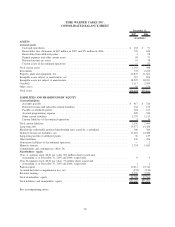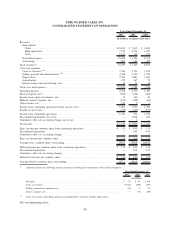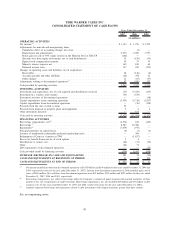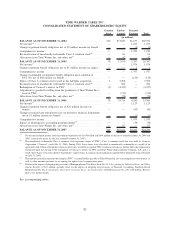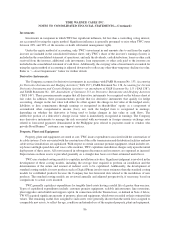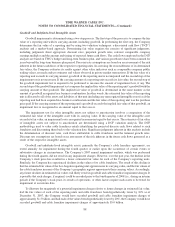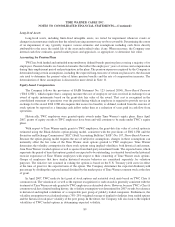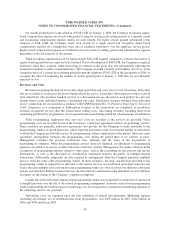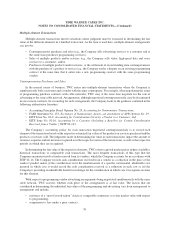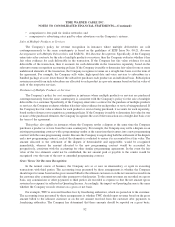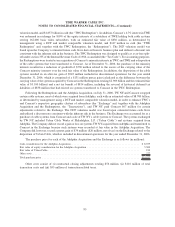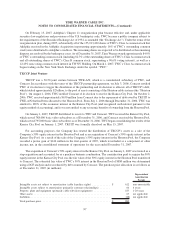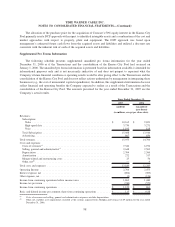Time Warner Cable 2007 Annual Report Download - page 93
Download and view the complete annual report
Please find page 93 of the 2007 Time Warner Cable annual report below. You can navigate through the pages in the report by either clicking on the pages listed below, or by using the keyword search tool below to find specific information within the annual report.Goodwill and Indefinite-lived Intangible Assets
Goodwill impairment is determined using a two-step process. The first step of the process is to compare the fair
value of a reporting unit with its carrying amount, including goodwill. In performing the first step, the Company
determines the fair value of a reporting unit by using two valuation techniques: a discounted cash flow (“DCF”)
analysis and a market-based approach. Determining fair value requires the exercise of significant judgments,
including judgments about appropriate discount rates, perpetual growth rates, relevant comparable company
earnings multiples and the amount and timing of expected future cash flows. The cash flows employed in the DCF
analyses are based on TWC’s budget and long-term business plan, and various growth rates have been assumed for
years beyond the long-term business plan period. Discount rate assumptions are based on an assessment of the risk
inherent in the future cash flows of the respective reporting units. In assessing the reasonableness of its determined
fair values, the Company evaluates its results against other value indicators such as comparable company public
trading values, research analyst estimates and values observed in private market transactions. If the fair value of a
reporting unit exceeds its carrying amount, goodwill of the reporting unit is not impaired and the second step of the
impairment test is not necessary. If the carrying amount of a reporting unit exceeds its fair value, the second step of
the goodwill impairment test is required to be performed to measure the amount of impairment loss, if any. The
second step of the goodwill impairment test compares the implied fair value of the reporting unit’s goodwill with the
carrying amount of that goodwill. The implied fair value of goodwill is determined in the same manner as the
amount of goodwill recognized in a business combination. In other words, the estimated fair value of the reporting
unit is allocated to all of the assets and liabilities of that unit (including any unrecognized intangible assets) as if the
reporting unit had been acquired in a business combination and the fair value of the reporting unit was the purchase
price paid. If the carrying amount of the reporting unit’s goodwill exceeds the implied fair value of that goodwill, an
impairment loss is recognized in an amount equal to that excess.
The impairment test for other intangible assets not subject to amortization involves a comparison of the
estimated fair value of the intangible asset with its carrying value. If the carrying value of the intangible asset
exceeds its fair value, an impairment loss is recognized in an amount equal to that excess. The estimates of fair value
of intangible assets not subject to amortization are determined using a DCF valuation analysis. The DCF
methodology used to value cable franchises entails identifying the projected discrete cash flows related to such
franchises and discounting them back to the valuation date. Significant judgments inherent in this analysis include
the determination of discount rates, cash flows attributable to cable franchises and the terminal growth rates.
Discount rate assumptions are based on an assessment of the risk inherent in the future cash flows generated as a
result of the respective intangible assets.
Goodwill and indefinite-lived intangible assets, primarily the Company’s cable franchise agreements, are
tested annually for impairment during the fourth quarter or earlier upon the occurrence of certain events or
substantive changes in circumstances. The Company’s 2007 annual impairment analysis, which was performed
during the fourth quarter, did not result in any impairment charges. However, over the past year, the decline in the
Company’s stock price has resulted in a lower estimated fair value for each of the Company’s reporting units.
Similarly, the Company has experienced declines in the values of its cable franchises. The result of this decline is
that the estimated fair value of the Los Angeles reporting unit approximates its carrying value, and the fair values of
the cable franchises in many of the Company’s geographic regions approximate their carrying values. Accordingly,
any future declines in estimated fair values will likely result in goodwill and cable franchise impairment charges. It
is possible that such charges, if required, could be recorded prior to the fourth quarter of 2008 (i.e., during an interim
period) if the Company’s stock price, its results of operations, or other factors require such assets to be tested for
impairment at an interim date.
To illustrate the magnitude of a potential impairment charge relative to future changes in estimated fair value,
had the fair values of each of the reporting units and cable franchises been hypothetically lower by 10% as of
December 31, 2007, the Company would have recorded goodwill and cable franchise impairment charges of
approximately $1.5 billion, and had each of the values been hypothetically lower by 20%, the Company would have
recorded goodwill and cable franchise impairment charges of approximately $5.0 billion.
88
TIME WARNER CABLE INC.
NOTES TO CONSOLIDATED FINANCIAL STATEMENTS—(Continued)



